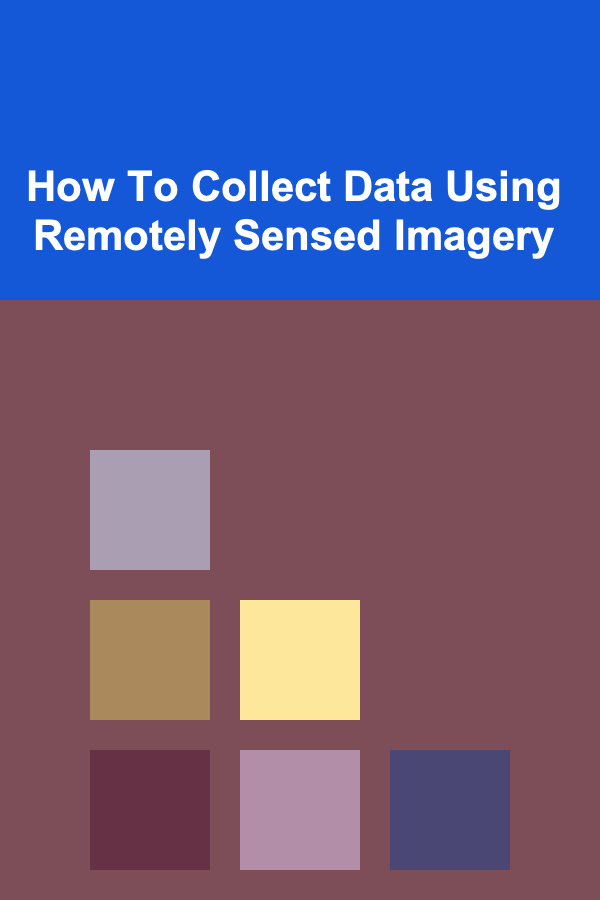
How To Collect Data Using Remotely Sensed Imagery
ebook include PDF & Audio bundle (Micro Guide)
$12.99$6.99
Limited Time Offer! Order within the next:

Remote sensing refers to the process of collecting information about objects or areas from a distance, typically using satellites or aircraft. Remote sensing imagery has become an indispensable tool in various fields such as environmental monitoring, agriculture, disaster management, urban planning, and climate studies. The advent of advanced technology has expanded the scope and accuracy of remote sensing, enabling users to obtain detailed, real-time data from virtually any location on Earth.
This article explores how to collect data using remotely sensed imagery, the different types of remote sensing techniques, the tools involved, the process of data acquisition, and the various applications of this valuable resource.
Understanding Remote Sensing
Remote sensing technology allows for the acquisition of data without physical contact with the subject being observed. It relies on sensors that detect electromagnetic radiation (EMR) reflected or emitted by objects. These sensors can be passive (relying on natural sources of energy, like sunlight) or active (emitting their own energy, such as radar systems). Remote sensing platforms, such as satellites, aircraft, and drones, carry these sensors to collect data over vast geographic areas.
Key Principles of Remote Sensing
-
Electromagnetic Spectrum: Remote sensing relies on detecting radiation across various wavelengths of the electromagnetic spectrum. Different materials on the Earth's surface reflect, absorb, or emit radiation differently depending on the wavelength. This allows remote sensing instruments to differentiate between types of land cover, vegetation, water bodies, and more.
-
Resolution: The resolution of remotely sensed imagery refers to the level of detail captured by the sensor. The three primary types of resolution are:
- Spatial Resolution: The smallest distance between two objects that can be differentiated in an image. Higher spatial resolution means more detailed images.
- Spectral Resolution: The ability of a sensor to capture different wavelengths of light, which allows for the identification of specific materials based on their spectral properties.
- Temporal Resolution: The frequency with which data is collected for a specific location. This is crucial for monitoring changes over time, such as vegetation growth or urban expansion.
- Radiometric Resolution: The sensitivity of a sensor to detect variations in signal strength, influencing the range of values that can be represented.
-
Sensors and Platforms: Remote sensing platforms range from low-altitude aircraft to high-altitude satellites, each carrying different sensors to capture imagery. The most common types of sensors used include:
- Optical Sensors: These sensors detect visible light and infrared radiation, which can be used to monitor vegetation health, land cover, and water bodies.
- Radar Sensors: Synthetic Aperture Radar (SAR) systems emit their own microwave signals and are used to collect imagery regardless of weather conditions or light levels.
- LiDAR (Light Detection and Ranging): This technology uses laser pulses to measure distances to the Earth's surface, providing detailed topographic data.
Types of Remotely Sensed Imagery
Remote sensing imagery can be classified into several types, depending on the wavelength of the radiation being detected and the platform used for data collection.
1. Optical Imagery
Optical imagery uses visible and infrared light to capture images of the Earth's surface. It is the most commonly used form of remote sensing imagery, with applications in agriculture, land use monitoring, and environmental management. Optical sensors are often installed on satellites like Landsat, WorldView, or MODIS, and can provide high-resolution imagery in both the visible spectrum (RGB) and near-infrared spectrum (NIR).
- Applications :
- Monitoring vegetation health and land cover.
- Identifying urban expansion.
- Mapping and monitoring water bodies.
- Assessing disaster damage such as floods or fires.
2. Radar Imagery (SAR)
Radar imagery uses microwave radiation to detect objects or surface features. Unlike optical sensors, radar sensors can operate in all weather conditions, day or night. Synthetic Aperture Radar (SAR) is a commonly used radar system in remote sensing.
- Applications :
- Mapping terrain and elevation data (topography).
- Detecting changes in surface structure (e.g., land subsidence or ground deformation).
- Monitoring deforestation and illegal logging.
- Assessing floodwaters or oil spills in areas with cloud cover.
3. LiDAR Imagery
LiDAR technology uses laser light to measure distances and create high-resolution 3D models of the Earth's surface. LiDAR sensors are typically mounted on aircraft or drones, and they provide precise data on terrain and vegetation structure.
- Applications :
- Generating topographic maps and digital elevation models (DEMs).
- Measuring vegetation height and canopy structure.
- Analyzing urban structures and infrastructure.
- Mapping forest biomass and carbon stocks.
Tools for Collecting Remotely Sensed Data
Collecting remotely sensed imagery requires specialized tools, including sensors, platforms, and software for data analysis.
1. Satellites
Satellites are the most common platform for collecting remotely sensed imagery. They orbit the Earth at various altitudes, providing global coverage and frequently capturing images of large areas. Some of the well-known Earth observation satellites include:
- Landsat: A series of satellites launched by NASA and the U.S. Geological Survey (USGS), which provide optical imagery for land use and vegetation studies. Landsat data is publicly available and widely used for environmental monitoring.
- WorldView: A series of commercial satellites that offer high-resolution imagery, often used for mapping, urban planning, and disaster response.
- Sentinel: A series of European Space Agency (ESA) satellites designed for monitoring the environment and climate change, providing optical and radar data.
2. Unmanned Aerial Vehicles (UAVs)
Drones or UAVs have become increasingly popular for collecting remotely sensed data due to their flexibility, cost-effectiveness, and ability to capture high-resolution imagery. UAVs can carry a variety of sensors, including optical cameras, LiDAR systems, and multispectral sensors. Drones are particularly useful for collecting data in areas that are difficult to access or for applications requiring frequent, localized data collection.
- Applications :
- Agriculture (crop monitoring and precision farming).
- Forestry (tree height, canopy structure).
- Environmental monitoring (wetland studies, coastal erosion).
- Infrastructure inspection (bridges, pipelines).
3. Aircraft
Manned aircraft equipped with remote sensing instruments are used for collecting data in regions that require more detailed or specialized data. Aircraft are typically flown at lower altitudes than satellites and are able to capture higher-resolution imagery. They are also useful in areas where satellite coverage may be inadequate, such as remote or restricted regions.
- Applications :
- High-resolution imagery for urban planning and zoning.
- Topographic surveys for construction projects.
- Environmental monitoring in inaccessible areas.
The Data Collection Process
The process of collecting remotely sensed data involves several key steps: data acquisition, preprocessing, analysis, and interpretation.
1. Data Acquisition
Data acquisition refers to the process of capturing the raw imagery from the chosen sensor platform. The platform---whether satellite, drone, or aircraft---collects electromagnetic radiation reflected or emitted by objects on the Earth's surface. The sensor records this information as raw data, which is later processed to create an image or map.
- Factors Affecting Data Acquisition :
- Timing: The time of day, season, and weather conditions can significantly impact the quality of remotely sensed imagery. For example, cloud cover can obscure optical imagery, while radar sensors can penetrate clouds.
- Platform Altitude: The altitude of the platform determines the resolution of the data. Satellites in low Earth orbit (LEO) provide higher resolution images than those in geostationary orbit.
- Sensor Type: The type of sensor used (optical, radar, LiDAR) will determine the type of data collected and its suitability for different applications.
2. Preprocessing
Raw remotely sensed data often needs to be preprocessed to correct for various distortions and to make the data usable for analysis. Preprocessing steps may include:
- Radiometric Calibration: Adjusting the data to correct for sensor noise and atmospheric interference.
- Georeferencing: Aligning the imagery with geographic coordinates to ensure the data corresponds to real-world locations.
- Cloud Removal: For optical imagery, cloud cover can obscure the surface, so algorithms are often used to detect and remove clouds from the data.
3. Analysis and Interpretation
Once the data is preprocessed, it can be analyzed to extract valuable information. Remote sensing analysis typically involves image processing techniques such as:
- Classification: Assigning different land types or features (e.g., water, vegetation, buildings) based on their spectral properties.
- Change Detection: Identifying changes in land cover over time, such as deforestation, urbanization, or crop growth.
- Feature Extraction: Identifying specific features or patterns in the data, such as roads, rivers, or buildings.
Geospatial software like ArcGIS, QGIS, ENVI, and ERDAS Imagine are commonly used for remote sensing data analysis, allowing users to visualize, interpret, and process the imagery.
4. Data Interpretation and Decision Making
The final step involves interpreting the processed data and using it to inform decision-making. This might include making predictions, creating maps, or providing reports for stakeholders in fields such as agriculture, forestry, urban planning, or environmental management.
Applications of Remotely Sensed Imagery
Remotely sensed imagery has a wide range of applications in various fields. Below are some of the most common uses of this technology:
1. Environmental Monitoring
Remote sensing is extensively used for monitoring and managing natural resources, environmental hazards, and climate change. It allows for large-scale monitoring of ecosystems, water bodies, and atmospheric conditions.
- Applications: Deforestation monitoring, drought assessment, land degradation, and coastal erosion.
2. Agriculture and Precision Farming
Farmers use remote sensing to monitor crop health, assess soil moisture, and optimize irrigation. UAVs and satellites can capture multispectral imagery to detect early signs of pest infestations or disease, enabling more efficient and targeted agricultural practices.
- Applications: Crop yield prediction, irrigation management, and precision agriculture.
3. Disaster Management
Remote sensing plays a crucial role in disaster response by providing real-time data about areas affected by natural disasters such as hurricanes, floods, and wildfires. This information helps in damage assessment, relief efforts, and recovery planning.
- Applications: Flood monitoring, wildfire detection, and earthquake damage assessment.
4. Urban Planning and Development
Cities use remote sensing data for urban planning, zoning, and infrastructure development. It helps in monitoring urban sprawl, mapping transportation networks, and assessing the condition of buildings and roads.
- Applications: Urban growth monitoring, infrastructure management, and land-use planning.
Conclusion
Collecting data using remotely sensed imagery offers vast potential for monitoring, managing, and analyzing the Earth's surface. The continuous advancement in sensor technology and data processing techniques has made it possible to gather high-resolution, reliable data on a global scale. The ability to monitor environmental changes, manage resources efficiently, and make data-driven decisions has revolutionized numerous sectors, from agriculture to disaster management.
By understanding the principles, tools, and processes involved in remote sensing, professionals can effectively use this technology to enhance their work in a variety of fields, contributing to sustainable development and better decision-making for the future.

How to Establish Communication Channels with Parents During Camp
Read More
How to Organize Your Entryway Closet with Storage Solutions
Read More
How To Organize Your Home with Minimalist Principles
Read More
How to Transform Your Home Office with Affordable Decor
Read More
How to Give Feedback in a Timely Manner
Read More
How To Brew Cold Brew Coffee at Home
Read MoreOther Products

How to Establish Communication Channels with Parents During Camp
Read More
How to Organize Your Entryway Closet with Storage Solutions
Read More
How To Organize Your Home with Minimalist Principles
Read More
How to Transform Your Home Office with Affordable Decor
Read More
How to Give Feedback in a Timely Manner
Read More